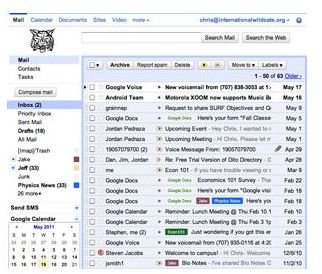Gmail For Schools: What Educators Need To Know
To Outsource Or Not To Outsource, That Is The Question
Moving to an IT provider such as Google raises a number of opportunities and challenges for schools, colleges and universities. On a fundamental level, it is important to understand that using the services provided by Google or one of its competitors involves outsourcing. This involves trusting Google with your correspondence and other sensitive information. Several years ago, the company’s privacy practices were considered lacking but there has been much improvement on this front over the past several years. For example, Google now has a strong privacy policy and takes efforts to protect user information more seriously. The privacy issue is simply one concern that can arise in outsourcing arrangements.
Before You Sign Up: IT and Change Management Planning

While many businesses have a long history of managing outsourced services, this arrangement may be new to your school or college. Run through this check list of issues to determine whether or not it makes sense to adopt Google Apps for Education (which includes Gmail) for your organization. To implement Google’s service, there are two broad sets of issues you should consider. First, you need to think through the IT issues and second, you need a plan to ensure that your organization adopts the new technology.
Schools and colleges have several special IT considerations and issues to think through. For example, Does your school or college have an IT policy? What about a supplier or outsourcing policy? Almost all schools will have some kind of “acceptable use of IT” policy in place.
In reviewing these documents, consider how you would apply this policies and procedures to an outsourced provider. Would you have to rewrite or rework the policy? If so, what would that involve? If it is not part of your existing policy, make sure that you address privacy and security matters in the policy.
If the new service passes the IT policy hurdle, you then can consider how this new service will impact your IT department and resources. If you manage the change effectively, you will free up IT staff and resources to provide better services to faculty and students. On the other hand, a failed implementation could raise concerns about job security and budget cuts - a discouraged IT department can be a liability when you are trying to adopt Gmail for schools.
The second half of the planning process involves communication, promotion and training. As you may know from previous projects, following a “if you build it, they will come” strategy rarely works. Once you have the new outsourced email service working, you need to develop a communications plan.
Depending on your resources, this can include writing up a one or two page memo describing the service and its benefits or offering in person training. You should assume that there will be many questions at first when the service is introduced, especially if the previous email service is being discontinued. Communication and training are important but not the only element of an effective a change management plan. Additional elements to consider include seeking support from senior staff and faculty members - without their involvement, the new service may be seen as an IT project rather than a project that can benefit the whole organization.
The Benefits of Outsourcing Email To Google

You’ve worked through the checklist of questions in the previous section and you have decided that you want to adopt Gmail for your school. It’s time to dig more deeply into the benefits of this service.
- Storage: Google offers more than 7 GB of storage for email, documents and other files. Even if students are constantly emailing large PDF and PowerPoint files back and forth, it is difficult to approach this limit.
- Branding: As shown in the screenshot, Google Apps for Education lets you brand the service with your school’s logos and other graphics.
- More Than Email: Google Apps For Education is actually a bundle of six different services. In addition to email, you can use Google Docs (a basic word processor, spreadsheet program and other office productivity apps), Google Calendar (keep track of appointments, deadlines and tasks) and Google Video for Education, a service for hosting and sharing video files.
- Advertisement Free: Unlike Gmail for the general public, Google Apps for Education does not display advertising.
- Uptime: Google services are generally very reliable - the general service standard is 99.9% uptime. If your school has more detailed requirements, you can contact Google to create your own service level agreement.
- Extra Security for K-12 Schools: Google offers “Google Message Security” for K-12 users to address the special security needs of this community. For more information on this, consult the resources section.
References
- Google Apps for Education - Common Questions, http://www.google.com/support/a/bin/answer.py?answer=139019&hl=en
- Google Apps for Education, http://www.google.com/apps/intl/en/edu/
- Google Message Security for K-12 Schools, http://www.google.com/support/a/bin/answer.py?answer=159594
- Image Credit: All screenshots from Google Apps for Education, http://www.google.com/apps/intl/en/edu/